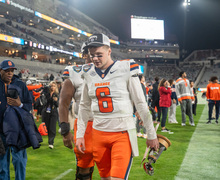SU community says technology needs to be more accessible for those with disabilities
Tony Chao | Art Director
While Blackboard is an essential component of many classes at Syracuse University, it is not easily accessible to one group of SU students: the blind.
“They’re not going to be able to engage with the material like everyone else and that puts everyone at a disadvantage because (they) may have some really deep insights that no one else sees, and the whole class will miss out on it because (they) (were)n’t able to read,”said Nick Holzthum, a junior in the School of Information Studies and Disability Student Union co-president.
The distribution of accessible technologies, or tools that help people with disabilities access media, is uneven across campus, with many departments unaware of the need for these technologies. At last week’s University Senate meeting, the Computing Services Committee presented a report outlining the use of these technologies on campus and what more needs to be done. Some suggestions included better campus-wide policies and the hiring of a full-time individual to coordinate these access issues.
In a report presented at the Senate meeting on Wednesday, Computing Services Committee chair Fred Easton said roughly 11 percent of students and 6 percent of faculty are disabled, according to the federal government definition.
In its report, the result of a year-long investigation into the issue, the committee recommended SU appoint a permanent Americans with Disabilities Act coordinator within the Information Technology and Services Department who would develop campus-wide policies for ensuring these technologies are universal.
Stephen Kuusisto, a professor in the Center on Human Policy, Law and Disability Studies in the School of Education who is blind, says SU has historically used websites and digital environments that aren’t accessible for those with disabilities.
“I think there’s a general sense that SU has to do better, but there’s been lack of rapid progress on addressing these issues in a sort of systematic way, which is why that faculty and staff committee has been working on this,” Kuusisto said.
Although he said this suggestion is a step in the right direction, it only covers a small portion of accessibility issues on campus. He said the university needs someone who focuses on more than just technology.
In addition, because SU doesn’t have a central officer like other universities, people in different departments don’t know how to make things accessible, he said.
But Holzthum, the Disability Student Union co-president, worries that because technologies like the websites and phones that students use have been so developed already that changing them will be difficult.
“If you try to slap it on afterwards you create a haphazard solution that works not all the time, and it’s not the best quality,” Holzthum said. “That’s going to be one of the big challenges at SU because we are already embedded in technology that’s not accessible, and it’s going to be very difficult for us to do away with the old so we can bring in the new.”
Disability Cultural Center director Diane Wiener said she’s happy to see this issue getting more attention, and feels that despite potential challenges, students, faculty and staff are on board and support the changes.
“What I’d love to see is have more people learning about this and have more people thinking about it — I feel like that’s already happening on our campus,” Wiener said. “Some people would like it to happen faster, some people would like it to have been already this way 20 years ago but we’ve been chiseling away at it.”
In the three years she has been a member of the SU staff and faculty, Weiner said she has seen changes, and although she feels there is a long way to go, this is an important step.
“We always want to make sure the people with disabilities have their needs met because they have the same right to education as everyone else who does not have a disability, but it is not just about the law, it’s about going beyond compliance,” Wiener said. “It’s about making sure that everybody has what they need, as much as that can be created.”
Michael Schwartz, an associate professor and director of the Disability Rights Clinic who is deaf, said people need to understand that this isn’t just an issue for people with disabilities. Although accommodations for those with disabilities are guaranteed by law, they benefit everyone, he added.
These technologies are important because they provide access but also send a message to the community in and outside SU that inclusion is valued, he said.
“When people with disabilities are seated at the table and made to feel they belong, everyone, and I mean everyone, benefits,” Schwartz said. “So my interpreter is not just my interpreter but ‘our’ interpreters in that the interpreter serves as a bridge between me and others who the need the interpreter as much as I do in order to communicate with me.”
Correction: For the Sept. 13 article, “SU community says technology needs to be more accessible for those with disabilities,” and editorial board “Technology must accommodate disabilities,” the accessibility of Blackboard was misstated. The program now meets standards set by the Americans with Disabilities Act and other required guidelines. The Daily Orange regrets this error.
Published on October 14, 2014 at 12:01 am
Contact Emma: ekbaty@syr.edu





